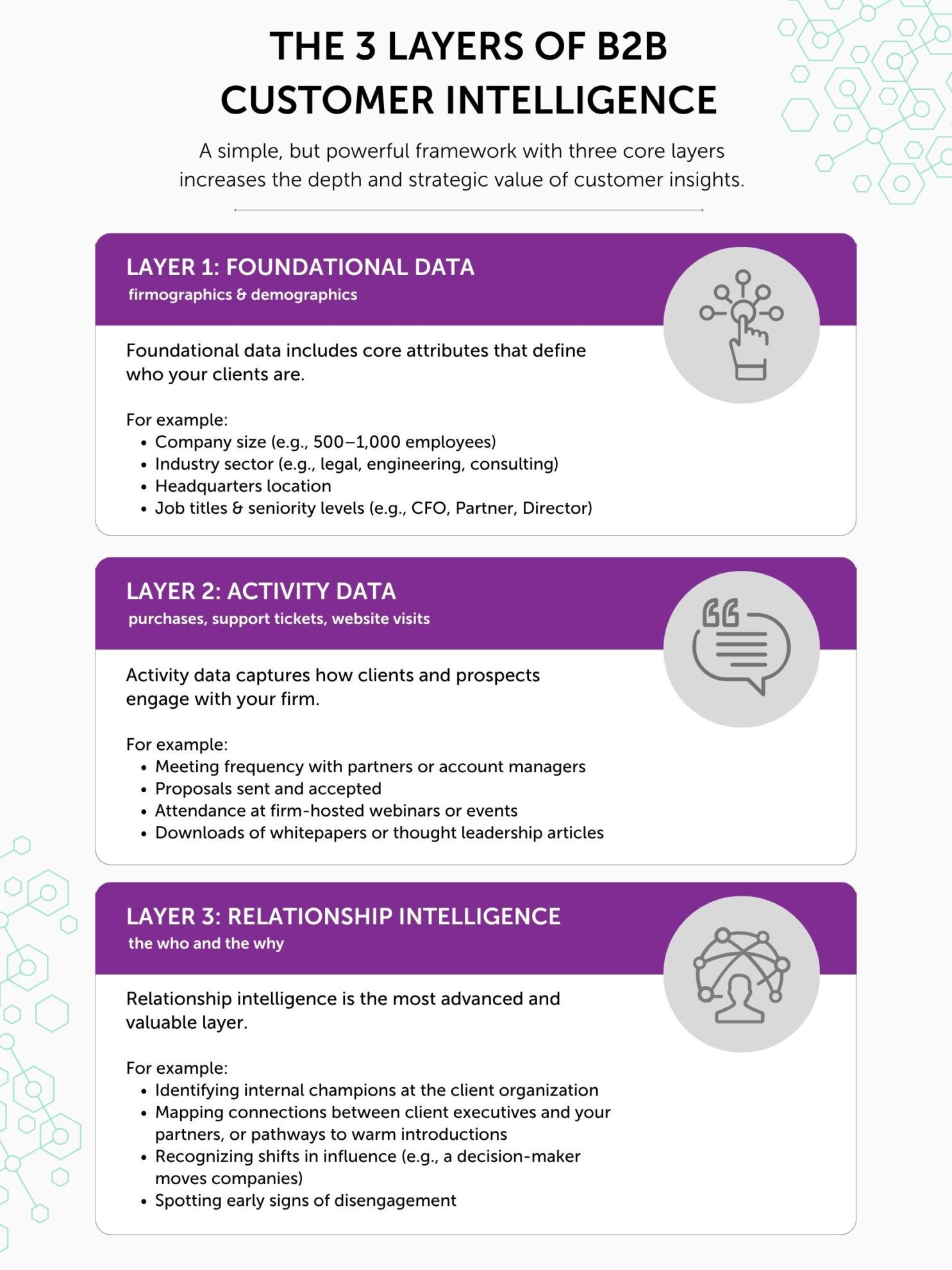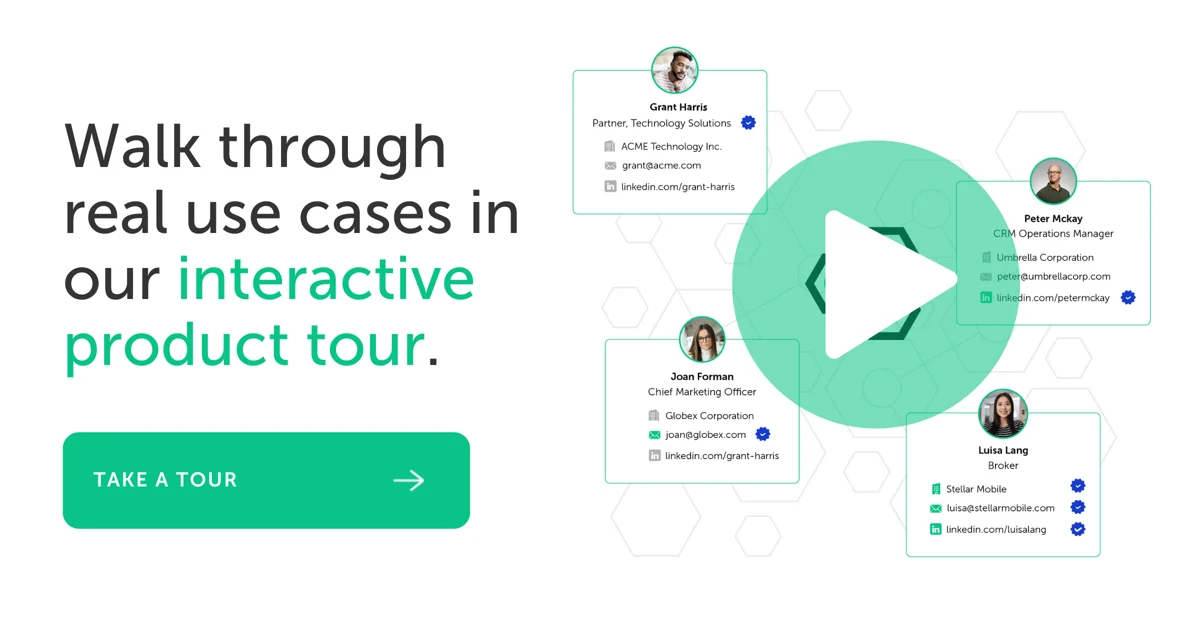Customer intelligence is commonly defined as the process of collecting and analyzing data to better understand and serve clients. But for firms in professional services, where trust, influence, and long-term relationships drive success, this definition lacks the nuance required for modern B2B customer intelligence.
Much of the mainstream conversation around customer intelligence focuses on transactional industries. These include sectors with short buying cycles, frequent interactions, and easily measurable digital signals. However, professional services firms operate in a more complex environment, where relationships unfold over months or years and involve multiple stakeholders.
True B2B customer intelligence must navigate organizational complexity, reveal hidden relationship dynamics, and surface insights that influence enterprise-level decisions. It is not just about tracking activity; it is about understanding context, mapping influence networks, and using data to drive high-value conversations with the right people at the right time.
In this guide, we reframe customer intelligence through a relationship-centric lens – one built for the complexity of B2B and professional services. See how automation reduces friction in data capture, and uncover real-world use cases that show how firms are turning relationship insight into competitive advantage.
Table of contents
Beyond B2C: why B2B customer intelligence requires a different approach
To understand how customer intelligence works in B2B, we must first recognize how it differs from the transactional models often discussed in consumer contexts.
In professional services, buying decisions are rarely made by a single individual. Committees of 8 to 13 stakeholders are common, each representing different functions and levels of influence. The challenge isn’t just identifying contacts; it’s understanding the organizational structure, internal dynamics, and informal influence paths that shape decisions.
Complicating matters further, many opportunities stall not because a competitor wins, but because clients choose to do nothing at all. This makes it essential to identify real buying intent, internal sponsorship, and relationship signals that suggest momentum. Unlike transactional industries, where clicks and conversions can signal engagement, customer intelligence in B2B must focus on mapping trust, influence, and readiness to act.
Individuals vs. buying committees
In consumer businesses, the buyer is usually a single decision-maker. In B2B, especially within professional services, purchasing decisions are typically made by buying committees. These groups may include executives, procurement leaders, department heads, and subject matter experts. Each person brings unique priorities and influence. Effective customer intelligence must identify the stakeholders involved in a buying process, clarify their roles within the decision‑making hierarchy, and reveal how your firm is connected to them through relationship networks that span both clients and internal team members.
Simple transactions vs. complex relationships
Consumer sales are often quick and linear. In contrast, B2B engagements evolve through a series of touchpoints, trust-building interactions, and strategic conversations. These relationships can span months or even years. A meaningful customer intelligence platform must go beyond recording activity to surface the context behind it, revealing which relationships are gaining momentum, which stakeholders are influencing outcomes, and where hidden opportunities or risks may exist.
The $3 trillion problem of bad data in B2B CRM
Poor data quality in CRM systems is a persistent challenge. Studies estimate it costs U.S. businesses over $3 trillion each year. For professional services firms, where each client relationship represents significant long-term value, bad data has real consequences. And while many firms are investing heavily in AI to address these challenges, just 1% say those efforts have reached maturity, highlighting a critical gap between intention and impact.
Manually entered information is often incomplete or quickly becomes outdated, largely because professionals in client-facing roles don’t have the time (or incentive) to keep records constantly updated. As data quality deteriorates, trust in the system erodes, and teams begin to rely on it less, which in turn accelerates the decline in data accuracy and utility.
The 3 layers of B2B customer intelligence
To help professional services firms structure their approach, we propose a simple but powerful framework with three core layers: foundational data, activity data, and relationship intelligence. Each layer increases the depth and strategic value of customer insight.
Layer 1: foundational data (firmographics & demographics)
Foundational data includes core attributes that define who your clients are. This includes firmographic details such as company size, industry, and location, as well as demographic information like job titles and levels of seniority. These elements are essential for segmentation and targeting, but on their own, they offer limited strategic guidance. Without behavioral context or relational insights, foundational data provides the “what,” but not the “how” or “why.”
Layer 2: activity data (purchases, support tickets, website visits)
Activity data captures how clients and prospects engage with your firm across key touchpoints. For professional services organizations, this includes email and calendar interactions, meeting frequency, proposal activity, event participation, and digital engagement such as visits to client portals or thought leadership content.
Unlike transactional data in product-based industries, these signals are often fragmented and buried across systems. Introhive centralizes and analyzes this engagement history automatically, providing a clear, consolidated view of client activity that helps teams assess momentum, identify disengagement early, and tailor outreach based on real interactions.
Layer 3: relationship intelligence (the who & the why)
Relationship intelligence is the most advanced and valuable layer. It provides insight into who holds influence within an account and how strong your relationships are with key stakeholders. This includes understanding internal champions, mapping introductions across teams, and recognizing early signs of momentum or disengagement.
Relationship intelligence is dynamic, continuously evolving as people change roles, teams shift, and new interactions occur. For professional services firms, where client loyalty and referral networks are critical, this layer delivers a real competitive edge.

How to gather B2B customer intelligence (without manual data entry)
Traditional CRM systems rely heavily on manual input, which makes it difficult to build a complete and up-to-date picture of client relationships. Client intelligence platforms solve this problem with intelligent automation.
Integrating with your existing CRM (e.g., Salesforce)
Introhive integrates seamlessly with major CRM platforms such as Salesforce and Microsoft Dynamics. It enriches your existing data, enhances usability, and improves adoption without requiring your team to change their daily workflows.
Passively capturing email and meeting activity
Introhive automatically captures metadata from emails and calendar meetings such as sender, recipient, timestamps, and invite details, without requiring users to manually log activity. This data is passively collected from existing systems like email and CRM platforms, helping maintain a continuous and reliable record of client engagement.
Critically, the platform does not access the body content or subject lines of emails (unless explicitly enabled), nor does it track time spent in meetings or on messages. It excludes personal interactions and internal meetings without external participants, upholding strict privacy standards.
This passive approach ensures more complete activity records, improves visibility into relationship health, and reduces the administrative burden on client-facing professionals, all while respecting user control and confidentiality.
Using AI to map relationship networks
By analyzing communication patterns, such as email frequency, meeting cadence, and response times, Introhive’s AI uncovers who your team is actively engaging with and how strong those relationships are.
This goes far beyond traditional CRM contact lists. Relationship intelligence can surface internal champions, highlight emerging influencers, and reveal hidden pathways into key accounts. These insights help client-facing teams identify warm introductions, mitigate risk, and prioritize outreach based on actual engagement strength beyond billing metrics.
Enriching contact and account data automatically
Introhive continuously enriches contact and account records with accurate, verified data, including updated job titles, reporting lines, and firmographic details from trusted sources. By automating this enrichment, the platform ensures that your CRM remains current and reliable without placing additional burden on client-facing professionals. This is especially important in a market where nearly 9 in 10 decision-makers now prioritize AI capabilities when evaluating CRM vendors, underscoring the growing expectation that platforms like Introhive deliver intelligence, not just infrastructure.
Automation leads to stronger data integrity and renewed confidence in the CRM, making it a dependable foundation for client engagement and growth strategies.
5 B2B customer intelligence use cases that drive revenue
Customer intelligence has real-world impact. It helps firms win new business, strengthen client relationships, and uncover opportunities that might otherwise be missed. For professional services organizations, these use cases are especially powerful in navigating complex buying dynamics and relationship networks.
1. Uncovering warm introduction paths to key accounts
In B2B and professional services, access is everything. Gaining a first meeting with the right stakeholder often hinges not on messaging, but on trust. The question isn’t just “Who do we want to reach?” It’s “Who already knows them, and can open a door for us?” Tools like Introhive help operationalize this by surfacing relationship data that aligns closely with the principles of the trust equation.
That’s why relationship intelligence is so essential.
B2B customer intelligence platforms like Introhive map your firm’s real-world network by creating a single view of communication and interaction history across every department of your organization as captured via email and calendar data. The result is a dynamic, searchable view of who knows whom, how well, and when they last engaged.
These insights allow teams to identify warm paths to priority contacts, whether through a colleague, a partner, or a prior client relationship, transforming cold outreach into warm, trusted introductions.
This capability is especially valuable for account-based growth and new market development. Business development leaders no longer need to rely on guesswork or internal email chains to uncover connection points. With client intelligence, they can see relationship strength scores across the firm and route outreach through the person most likely to get a response.
Firms using Introhive have reported increases of over 30% in internal referrals and cross-practice collaboration, driven by greater visibility into relationship capital that had previously lived in inboxes, spreadsheets, or siloed systems.
Want to see how relationship mapping works in real time? Take a quick interactive tour of the Introhive platform.
2. Identifying at-risk accounts before they churn
Introhive allows teams to track relationship strength and engagement trends at both the account In B2B environments, especially in professional services, relationships signal account health more accurately than project milestones or contract terms. Yet many firms don’t realize a client is at risk until it’s too late. This is where B2B customer intelligence plays a crucial role.
By analyzing engagement trends across email, calendar, and CRM data, customer intelligence platforms like Introhive help firms monitor relationship health in real time. A sudden drop in communication frequency, reduced meeting activity, or lack of contact with key stakeholders can signal a weakening relationship, even if the account appears stable on paper.
These insights help identify two common risk patterns: low overall engagement and narrow relationship coverage. For example, if only one individual at a client account is actively engaged (or if no activity has occurred in weeks) your team can be alerted to re-engage before the account quietly churns. These signals support multithreading by prompting teams to strengthen relationships across functions and seniority levels, reducing dependency on any single contact.
Firms that use this kind of intelligence can proactively strengthen account coverage and prevent silent attrition. In a world where most clients leave not because of poor service, but because they feel neglected, relationship visibility becomes a critical advantage.
As Colleen Moorehead, Chief Client Officer at Osler, puts it: “Technology like Introhive enables our firm to focus on the future and collaborate with clients to explore creative ways to break new ground, advance our service offerings, and deliver more value to our clients.”
Want to know more? Download the Osler customer case study.
3. Prioritizing accounts based on relationship strength, not just spend
In many firms, account prioritization is driven by historical revenue or near-term commercial potential. While this can be helpful, it often overlooks a more predictive metric: relationship strength.
Strong relationships, especially with decision-makers or influencers are a better indicator of opportunity than deal size alone. A smaller account with multiple active advocates may be more likely to grow or convert than a larger one with minimal or passive engagement.
B2B customer intelligence surfaces these dynamics by analyzing how connected your team is to each stakeholder, how frequently they engage, and how those relationships are trending over time.
This intelligence helps revenue and client service teams shift from reactive account management to strategic prioritization. Relationship strength scores, for example, can be used to:
- Focus outreach on accounts with high engagement and growing influence networks
- Identify stalled opportunities that may need executive attention
- Evaluate which professionals are best positioned to lead a pursuit or relationship
In practice, firms are also using this insight to enhance matter allocation and pitch preparation. If a potential client has strong ties to a particular team or partner, that relationship becomes a differentiator in how the work is delivered.
B2B customer intelligence tools like Introhive make these patterns visible and actionable. By quantifying something previously subjective (relationship strength) firms are better able to align their resources to where they’re most likely to win, grow, and retain business.
Want to see what this looks like in action?
Explore our interactive demo to follow a day in the life of a partner and see how relationship intelligence helps drive better client alignment and manage client opportunities to ensure maximum growth.
4. Improving sales and marketing alignment with shared insights
In theory, sales and marketing teams should work in lockstep. In practice, they often operate from separate systems, disconnected workflows, and incomplete client data. That disconnect leads to misaligned messaging, poorly timed outreach, and missed opportunities, especially in complex B2B and professional services environments.
B2B customer intelligence brings clarity and cohesion.
Platforms like Introhive automatically capture relationship and activity data such as email touchpoints, meeting history, and engagement frequency, and enrich CRM records in the background. This gives both marketing and client-facing teams access to the same up-to-date insights, allowing them to coordinate outreach based on what’s actually happening within each account.
Platforms like Introhive automate contact maintenance and enrich CRM records behind the scenes with ongoing interaction history. This ensures both marketing and client-facing teams view the same real-time relationship data. When both teams operate from a shared source of truth, they can coordinate outreach based on genuine engagement signals rather than fragmented lists or outdated intuition.
Marketing teams benefit by being able to segment target audiences using factors like relationship strength, contact seniority, and recent activity. One study showed that Introhive helps firms uncover on average 350 additional contacts per user – data points previously buried in inboxes or offline networks. With those enriched, compliant data sets, marketing can run highly targeted campaigns that convert more effectively and hand off warmer leads to sales.
Sales and partners then benefit from marketing that truly complements their outreach and campaign timing aligns with current relationship dynamics.
“With Introhive, the process of identifying who knows who at key accounts is automatic. That’s a big win for our firm because we are reaching clients and prospects that we have missed out on for all these years, while simultaneously reducing workload for the partners, as well as marketing.” – Adelle Erdman, Executive Director of Marketing, Frazier & Deeter
Want to know more? Download the Frazier & Deeter customer case study.
5. Mapping whitespace for cross-sell and up-sell opportunities
Account growth depends on knowing where untapped opportunity exists. Introhive provides visibility into which departments, regions, or contacts within an existing client have not yet been engaged. This enables teams to identify whitespace for expansion and proactively position cross-practice capabilities.
For example, LBMC uses Introhive to support new service line leaders by identifying which internal colleagues had the strongest client relationships. “I use Introhive every day. To me, it is such a powerful tool to be able to look at when we’re doing market research or when we’re trying to identify cross-selling opportunities,” Kristen Petrel, Director of Industry Segments and Client Growth said. “We had a new service line person coming in who had five targets, and I was able to go into CRM, go into Introhive, and tell him who internally had the best relationships and facilitate internal meetings so that he could get in front of that client.”
Choosing a customer intelligence platform: key B2B features
Selecting the right B2B customer intelligence platform is a strategic decision, especially when client relationships are long-term, multi-threaded, and high-value. The ideal solution should not only solve today’s data challenges but also scale with your firm’s evolving needs.
Selecting the right B2B customer intelligence platform is a strategic decision, especially when client relationships are long-term, multi-threaded, and high-value. The ideal solution should not only solve today’s data challenges but also scale with your firm’s evolving needs.
Here are four essential capabilities to evaluate when comparing platforms:
Automated data capture & enrichment
CRM data is only as valuable as it is accurate, yet most firms struggle to keep it that way. Professionals are focused on serving clients, not entering contact details or logging meetings. Over time, this leads to incomplete records, stale information, and a system that people stop trusting.
Customer intelligence platforms like Introhive take that burden off the team by passively capturing relationship activity, and enriching records behind the scenes. Contacts are kept current, firmographic details are filled in, and reporting structures are updated automatically. This reduces reliance on manual entry and ensures your client data stays usable, complete, and trustworthy.
Relationship mapping & scoring
Most firms don’t suffer from a lack of relationships – they suffer from a lack of visibility into them. Introhive automatically maps relationships across the entire organization and scores the strength of those relationships based on frequency, recency, and mutual engagement, giving you a clear view into where trust already exists.
This helps teams identify warm paths into key accounts, understand who internally is best positioned to make an introduction, and uncover gaps in account coverage before they become risks. Instead of relying on memory or internal emails to find connection points, relationship mapping gives firms a shared, data-driven understanding of who knows whom, and how well.
Seamless CRM integration
CRMs are meant to be a central hub for client data, but too often they fall short when information is incomplete, outdated, or locked in silos. Introhive enhances the value of your existing CRM by automatically enriching contact and relationship data, and delivering it where your teams already work.
The platform is CRM-agnostic, with integrations across Salesforce, Microsoft Dynamics, Intapp, HubSpot, and others. Relationship insights appear natively in your CRM as well as in tools like Outlook and Microsoft Teams, making it easy for professionals to access context and take action without changing their workflow.
Enterprise-grade security & compliance
Client data is one of your firm’s most sensitive and valuable assets. Whether you’re working with global enterprises or regulated industries, maintaining strict security, privacy, and compliance standards is non-negotiable. Any customer intelligence platform you adopt must uphold these expectations without compromising accessibility or performance. This includes encryption, role-based access, audit trails, and adherence to frameworks like GDPR, CCPA, and SOC 2.
Introhive is built with security at its core. The platform allows firms to control data visibility and sharing preferences at every level (individual, team, practice, and firm-wide), ensuring sensitive information stays protected without compromising insight.
Introhive: the relationship-driven customer intelligence platform
As B2B firms seek smarter, more scalable ways to grow client relationships and drive revenue, customer intelligence has become essential. But not all platforms are built for the complexity of professional services.
Introhive was designed from the ground up to serve the unique relationship dynamics of B2B organizations. Our platform combines powerful data automation, proprietary relationship intelligence, and deep CRM integration, giving firms a complete, always-current view of their client ecosystem.
From surfacing warm introduction paths and strengthening account coverage to improving sales and marketing alignment and preventing silent churn, Introhive helps firms operationalize their most valuable asset: their relationship capital.
With Introhive, your team gains more than just cleaner data, They gain the visibility, context, and intelligence needed to drive growth, win new business, and deliver more value to every client.
Ready to see it in action? Book a demo with our team or take a 3-minute tour and discover what relationship-driven customer intelligence looks like in practice.






